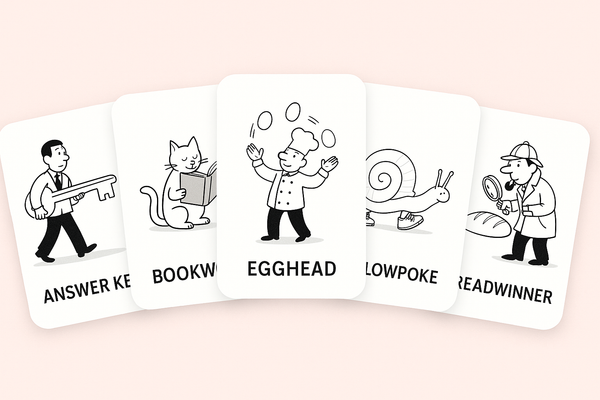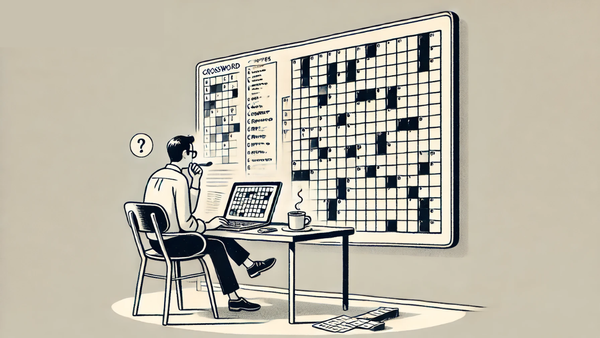7 Essential Cryptic Crossword Rules for Beginners
Unlock the secrets of cryptic crosswords with essential rules and strategies to enhance your solving skills and confidence.

Cryptic crosswords are not your typical puzzles. They combine wordplay, misdirection, and clever clues to challenge both your vocabulary and lateral thinking. Each clue has two parts: a straightforward definition and a cryptic wordplay element. To get started, here are seven rules that can help you decode even the trickiest puzzles:
- Definition and Wordplay: Every clue has two components - one directly hints at the answer, while the other involves wordplay like anagrams or hidden words.
- Clue Types: Familiarise yourself with common types like anagrams, charades, reversals, containers, deletions, and homophones.
- Indicator Words: Look for words that signal the clue type, such as "broken" for anagrams or "sounds like" for homophones.
- UK-Specific References: Be prepared for British spellings, slang, and cultural references like cricket terms or historical figures.
- Simple Clues First: Start with easier types like anagrams or hidden words to build confidence.
- Use Crossing Letters: Solving one clue gives you letters that intersect with others, making neighbouring answers easier to guess.
- Careful Reading: Pay attention to every word and punctuation mark, as they often hide clues or misdirection.
These rules form the foundation for solving cryptic crosswords. Regular practice and paying attention to patterns will make the process smoother and more enjoyable. Ready to give it a go?
7 Core Rules for Beginners
Now that you’ve got a handle on the basics of cryptic crosswords, it’s time to dive into the essential rules that can turn a baffled beginner into a skilled solver. These steps build on the clue structure we’ve already covered and will help you approach each puzzle with confidence.
1. Understand the Definition and Wordplay
Every cryptic clue is made up of two parts: a straightforward definition of the answer and a wordplay element that offers a clever way to arrive at the same solution. The definition acts like a standard crossword clue, giving you a synonym or direct hint, while the wordplay uses techniques like rearranging letters or combining words to point you in the right direction.
The definition will always be at the start or the end of the clue - never tucked in the middle. For example, in the clue "Chaperone shredded corset", the definition is "chaperone" (leading to the answer ESCORT), and "shredded corset" signals an anagram of CORSET.
Keep in mind that the literal meaning of the clue is often a red herring. The setter’s goal is to make the clue sound natural while cleverly disguising its true intent.
2. Learn Common Clue Types
Cryptic crosswords rely on a handful of standard clue types, each with its own unique logic. Anagrams, for instance, involve rearranging letters, while hidden word clues contain the answer embedded within the clue itself.
Other common types include:
- Charades: Smaller words are combined to form the answer. For example, "Outlaw leader managing money" combines BAN and KING to form BANKING.
- Containers: One word is placed inside another.
- Reversals: You’re asked to read a word backwards.
- Deletions: Letters are removed based on cues like "beheaded" (drop the first letter) or "endless" (remove the last letter).
- Homophones: The answer sounds like another word, as hinted by phrases like "I hear" or "on the air."
Mastering these types will make tackling clues much easier.
3. Recognise Indicator Words
Indicator words are like signposts, showing you what kind of wordplay is being used. For anagrams, look for words like "broken", "confused", or "shredded." Hidden word clues might use phrases like "a bit of" or "buried in." For containers, watch for terms like "holding", "inside", or "devouring." Reversals are flagged by words like "flipped" or "reversed."
Deletion indicators include hints like "absent", "cut", or "excluding", while homophones use phrases such as "sounds like" or "heard." Spotting these indicators is a key skill that will help you solve clues more efficiently.
4. Focus on UK-Specific Conventions
British cryptic crosswords often draw heavily on UK spellings, references, and cultural elements. Expect to see British spellings like "colour" instead of "color" and "realise" instead of "realize."
Clues might also touch on British television, historical figures, cricket terms, pub lingo, or slang. These references add a distinct flavour to the puzzles and are worth familiarising yourself with to decode clues more smoothly.
5. Start with Simple Clues
If you’re just starting out, focus on clue types that are easier to spot and solve. Anagrams and hidden word clues are great for beginners because their patterns are straightforward and easy to recognise.
Once you’ve got the hang of these, move on to slightly more complex types like containers and charades. Double definitions are another good starting point since they provide two different meanings for the same word. For example, "Not seeing window covering" leads to the answer BLIND.
6. Use Crossing Letters Strategically
The grid layout of cryptic crosswords works to your advantage. Solving one clue gives you letters that intersect with others, making it easier to crack neighbouring answers. Start with clues where you can guess part of the answer, then use the crossing letters to narrow down possibilities for the surrounding clues.
Look out for common patterns like ING or TH to guide your guesses. The number of letters in the answer, shown in parentheses, is also a useful tool for eliminating unlikely options.
7. Read Clues Carefully
Cryptic crossword setters are masters of misdirection, using punctuation and phrasing to throw you off track. Every word and symbol in a clue is intentional, and even subtle punctuation can change the meaning entirely.
For example, question marks often signal a pun or cryptic definition that requires lateral thinking. A clue like "Flower of London?" doesn’t refer to a plant - it’s hinting at something that flows through London, leading to the answer THAMES. Reading clues multiple times and considering alternative interpretations can reveal both the definition and the wordplay.
Paying close attention to detail is the cornerstone of solving cryptic crosswords.
Practical Strategies for Solving Cryptic Crosswords
Now that you're familiar with the core rules, it's time to dive into practical strategies that can make tackling cryptic crosswords feel less daunting. These techniques will help you approach puzzles more efficiently while honing your solving skills step by step.
Start with the Easiest Clues
When you first look at a cryptic crossword, begin by scanning for anagrams and hidden word clues - these are often the most straightforward to solve.
For hidden word clues, keep an eye out for indicator words like "part of", "in", "showing", or "some." These phrases suggest the answer is hidden within the clue itself, with the letters appearing in sequence.
With anagrams, look for words that hint at rearrangement, such as "mix", "scramble", "reform", "fix", or even more playful terms like "muck up" or "disorient." Once you've identified a potential anagram, count the letters in the fodder (the word or phrase to be rearranged) and check if it matches the length of the answer.
Interestingly, long clues can sometimes be easier than shorter ones. A 15-letter answer might seem intimidating, but solving it early can give you a significant number of crossing letters, making the rest of the puzzle more approachable.
Work Systematically
Adopting a systematic approach can prevent you from feeling overwhelmed. Start by working through all the across clues, then move on to the down clues - or vice versa. This method keeps things organised and helps you maintain momentum.
Pay attention to the enumeration - the numbers in brackets that show the length of the answer. If a short answer has an unusually long clue, it might indicate a simpler clue type or a specific trick.
Once you've solved a clue, fill in the crossing letters for intersecting words. This creates a snowball effect, where each solved clue makes the surrounding ones easier. Look out for common endings like -TION, -NESS, or -MENT, as well as frequent letter combinations like QU, TH, or CH. These can help you refine partial answers.
If you get stuck on a clue, mark it and come back to it later. Sometimes, stepping away and returning with fresh eyes can make all the difference.
Use Patterns and Themes
As you gain confidence, start looking for recurring patterns or themes within the crossword. Many puzzles include subtle motifs or repeated clue structures that can offer valuable hints once you spot them. For example, you might notice repeated indicator words or similar clue constructions that guide your approach to unsolved clues.
Familiarity with common British English letter combinations - like endings such as -TION, -NESS, or -MENT, and frequent pairs like QU, TH, or CH - can also be incredibly helpful. When you have partial letters from crossing clues, these patterns can narrow down your options significantly.
Over time, you'll notice that different setters have their own unique styles. Some may favour anagrams, while others lean heavily on hidden words or specific indicator phrases. Recognising these individual quirks can speed up your solving process as you get used to their techniques. Daily practice is key to spotting these patterns and improving your skills.
Using Daily Cryptic to Build Your Skills

Now that you’ve got a handle on the basics and some solid strategies under your belt, it’s time to put them to work. Daily Cryptic is a platform designed to make cryptic puzzles both approachable and enjoyable, offering tools and resources to help you sharpen your skills.
Features for Beginners
Daily Cryptic offers a step-by-step hint system that breaks down clues into manageable parts. Instead of leaving you stuck on tricky wordplay, it provides tailored explanations that reveal the logic behind each clue. This is especially helpful when you’re grappling with tough anagrams or layered double definitions.
The platform also delivers daily challenges and themed puzzles sourced from well-known publications. This variety introduces you to different setters’ styles and clue formats, helping you become a more versatile solver.
For bite-sized practice, Daily Cryptic includes mini-games focused on wordplay, anagrams, and clue structures. These quick sessions are perfect for building confidence without the commitment of tackling a full puzzle.
Track Your Progress
One standout feature of Daily Cryptic is its progress tracking system. It breaks down your performance by clue type - whether it’s double definitions, hidden words, or homophones - so you can pinpoint where you excel and where you need more practice. This targeted feedback ensures your efforts are focused where they’ll make the biggest impact.
The platform also adapts to your skill level with dynamic difficulty settings. As you improve, the puzzles adjust to keep you challenged but not overwhelmed, ensuring a steady progression in your abilities.
For an added layer of motivation, you can create an account to track your progress over time and even compete with friends. This social element makes learning more engaging and adds a bit of friendly competition to your cryptic crossword journey. The combination of progress tracking and adaptive challenges aligns seamlessly with the strategies you’ve already learned.
Practice Makes Perfect
Daily Cryptic makes practising easy and accessible, offering daily puzzles and features completely free of charge. This means you can practise as much as you like without worrying about cost.
Every puzzle you solve strengthens your understanding of cryptic clues, preparing you to tackle puzzles from any setter or publication with confidence.
Conclusion
Cryptic crosswords might feel intimidating at first glance, but by following these key rules, you'll gain the confidence to tackle even the most baffling clues. From spotting indicator words to understanding UK-specific conventions, each rule adds another layer to your toolkit, helping you make sense of even the trickiest puzzles. Let’s revisit the essentials to keep you on track.
Build a Strong Foundation
The seven core rules are your starting point for solving cryptic crosswords. They teach you how to break clues into smaller, more manageable parts, spot the logic behind their construction, and interpret both the definition and the wordplay. Whether you're solving a straightforward anagram or working through more intricate clues, these rules give you the structure you need to approach puzzles systematically.
Common stumbling blocks - like overthinking, missing indicator words, or overlooking UK-specific references - become less of an issue as you practise and apply these principles consistently.
Practice Makes Progress
Turning these rules into second nature takes time and regular practice. Start with beginner-friendly puzzles and gradually move to more complex grids. Use crossing letters to narrow down possibilities and confirm your guesses - this technique will soon become second nature.
For structured practice, Daily Cryptic offers free daily puzzles, complete with step-by-step explanations to reinforce your learning. It even tracks your progress, helping you identify which types of clues you excel at and which need more attention. By practising regularly and strategically, you'll see steady improvement.
Savour the Experience
Solving cryptic crosswords is as rewarding as it is challenging. Many solvers describe the process as deeply satisfying, with each puzzle boosting both your skills and your confidence.
These puzzles combine language, logic, and lateral thinking in a way that's uniquely engaging. As you apply the seven rules and refine your strategies, you'll find that the once-confusing wordplay transforms into an enjoyable mental challenge. Each "aha!" moment when a clue finally clicks makes the effort worthwhile. With patience and practice, you'll soon be solving puzzles that once seemed impossible.
FAQs
How do I easily spot the definition and wordplay in a cryptic crossword clue?
When tackling cryptic crossword clues, you'll usually find the definition placed at either the beginning or the end of the clue. This part is typically a straightforward synonym or description of the answer. On the other hand, the wordplay offers a more puzzling path to the same solution, often involving clever tricks like anagrams, abbreviations, or breaking words into parts.
To decode the wordplay, keep an eye out for indicator words. These are hints that signal the type of wordplay being used. For example, "rearranged" points to an anagram, "initially" suggests using the first letters of words, and "sounds like" indicates a homophone. Getting familiar with these cues can make it easier to separate the definition from the wordplay and solve clues with confidence.
How can I get better at spotting UK-specific references in cryptic crosswords?
To get better at spotting UK-specific references in cryptic crosswords, it helps to dive into the world of British culture and geography. Clues often touch on UK cities, counties, landmarks, institutions, and even historical figures or events.
Keep an eye out for abbreviations commonly used in British puzzles. For instance, "L" might stand for London, while "NI" could represent Northern Ireland. You'll also encounter British idioms, slang, and nods to cultural staples like classic TV shows, famous authors, or popular sports. Spending time with British media, literature, and current events can gradually build your familiarity with these elements.
The more you immerse yourself in UK-specific knowledge, the quicker you'll become at identifying and solving these uniquely British clues - a key feature of cryptic crosswords from the UK.
Why should beginners focus on anagrams and hidden words when starting cryptic crosswords?
Focusing on anagrams and hidden words is a smart way for beginners to dive into cryptic crosswords. These clue types tend to be more straightforward and pop up often in puzzles, making them easier to spot and solve.
Practising with these simpler clues not only builds your confidence but also hones your ability to recognise patterns. Over time, you'll develop the essential skills needed to handle trickier clue types as you advance.
When tackling cryptic crossword clues, you'll usually find the definition placed at either the beginning or the end of the clue. This part is typically a straightforward synonym or description of the answer. On the other hand, the wordplay offers a more puzzling path to the same solution, often involving clever tricks like anagrams, abbreviations, or breaking words into parts.
To decode the wordplay, keep an eye out for indicator words. These are hints that signal the type of wordplay being used. For example, "rearranged" points to an anagram, "initially" suggests using the first letters of words, and "sounds like" indicates a homophone. Getting familiar with these cues can make it easier to separate the definition from the wordplay and solve clues with confidence.
To get better at spotting UK-specific references in cryptic crosswords, it helps to dive into the world of British culture and geography. Clues often touch on UK cities, counties, landmarks, institutions, and even historical figures or events.
Keep an eye out for abbreviations commonly used in British puzzles. For instance, "L" might stand for London, while "NI" could represent Northern Ireland. You'll also encounter British idioms, slang, and nods to cultural staples like classic TV shows, famous authors, or popular sports. Spending time with British media, literature, and current events can gradually build your familiarity with these elements.
The more you immerse yourself in UK-specific knowledge, the quicker you'll become at identifying and solving these uniquely British clues - a key feature of cryptic crosswords from the UK.
Focusing on anagrams and hidden words is a smart way for beginners to dive into cryptic crosswords. These clue types tend to be more straightforward and pop up often in puzzles, making them easier to spot and solve.
Practising with these simpler clues not only builds your confidence but also hones your ability to recognise patterns. Over time, you'll develop the essential skills needed to handle trickier clue types as you advance.




